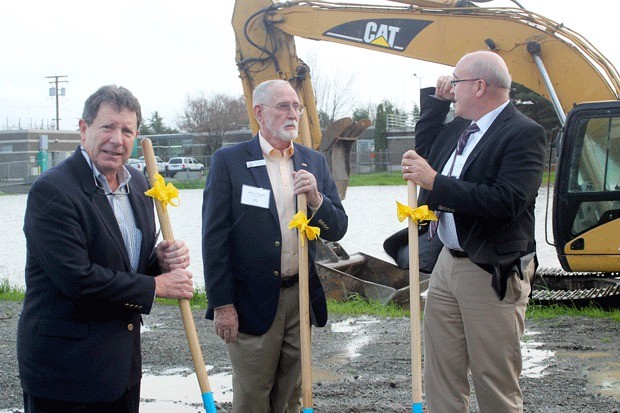Just as Oak Harbor city leaders celebrated the groundbreaking for a new sewage treatment plant with matching blue shovels Tuesday, things were going very wrong at the old plant.
The city narrowly avoided dumping thousands of gallons of untreated waste into the harbor.
About five years ago, the city stopped treating wastewater at the waterfront. The old plant was falling apart. So the city began pumping its wastewater to the Seaplane Base, where the Navy treats its sewage.
Heavy rains and strong winds whipped through the city during the groundbreaking Tuesday afternoon at Windjammer Park. By then, rain had pelted the city off and on for a few days.
In the worst event city engineer Joe Stowell can remember, the city handled 5 million gallons of wastewater in one day. On Tuesday, it took in more than 6 million.
He called it “a 50- to 100-year event.”
Right in the middle of it, the aptly named pump No. 2 broke.
“It crapped out,” Stowell said jokingly.
The old plant was still there, so officials diverted sewage into the empty tanks. It quickly became clear the tanks wouldn’t hold it all.
The city tries to keep rainwater from draining into the system, but there are still places stormwater sneaks in. By late afternoon, the combination of rain and whatever everyone sends down their pipes was rapidly filling the tanks. The stuff was inches from overflowing.
The city had few choices — release it untreated into the harbor or let it overflow.
Officials immediately imposed restrictions on water use, telling customers to stop sending anything into the system.
Notices were quickly issued and posted on www.whidbeynewstimes.com, the Whidbey News-Times Facebook page and on the city’s public access channel.
It was all hands on deck, with dozens of city employees onsite brainstorming solutions or at lift stations monitoring the flow.
An employee from the water department made good speed toward Kent to pick up a rental pump.
All the company’s trucks were already delivering pumps to other treatment plants in trouble.
It became clear he wouldn’t make it back in time.
At around 5 p.m., city officials called their friends at the Oak Harbor Fire Department for a hand. Deputy chief Mike Buxton was on duty.
“It was pretty frantic,” he said. “They had a lot to worry about. The pump failed. The tanks were filling with water. It was a bad situation.”
Then someone had an idea. Not far away was a big hole in the ground from the construction of the new treatment plant. It was already partly filled with rainwater and groundwater. Why not pump it there? They still had a functioning portable pump working well enough to get the liquid moving a few hundred feet.
Firefighters showed up with a flatbed truck loaded with pipe. In the midst of dark, driving rain and howling wind, they helped get a line set up to pump the near-overflowing waste.
“It was impressive, it was organized chaos,” Stowell said. “You had firefighters running by yelling, ‘I got the bolt cutters!’”
Meanwhile, city crews sent the sewage through several chambers, letting anything solid settle to the bottom. They partially treated it with chlorine before pumping it. In total, they moved 300,000 gallons of effluent. Firefighters were back at the station within an hour, ready to help with the rest of the storm chaos.
Mother Nature just underscored why the city couldn’t delay building a new plant, said city councilwoman Tara Hizon.
“We aren’t building this new one a moment too soon,” she said.
The next day, city crews got the pump from Kent running and were able to move the stored effluent to the Seaplane Base for treatment.
So many people were involved in averting disaster, Stowell is hesitant to praise any single person.
“Let’s just say that city staff and our outside support companies performed above and beyond in an effort to prevent contaminating the Sound with sewage,” he said.
“At this point, I feel like singling out particular individuals would be an injustice to the teamwork I observed.”
The new sewage treatment plant is scheduled to go online in 2018. Two firms working on the project recently came up with separate estimates for the cost of constructing the plant.
One firm pegged the number at $91.3 million and the other estimated about $110 million.



